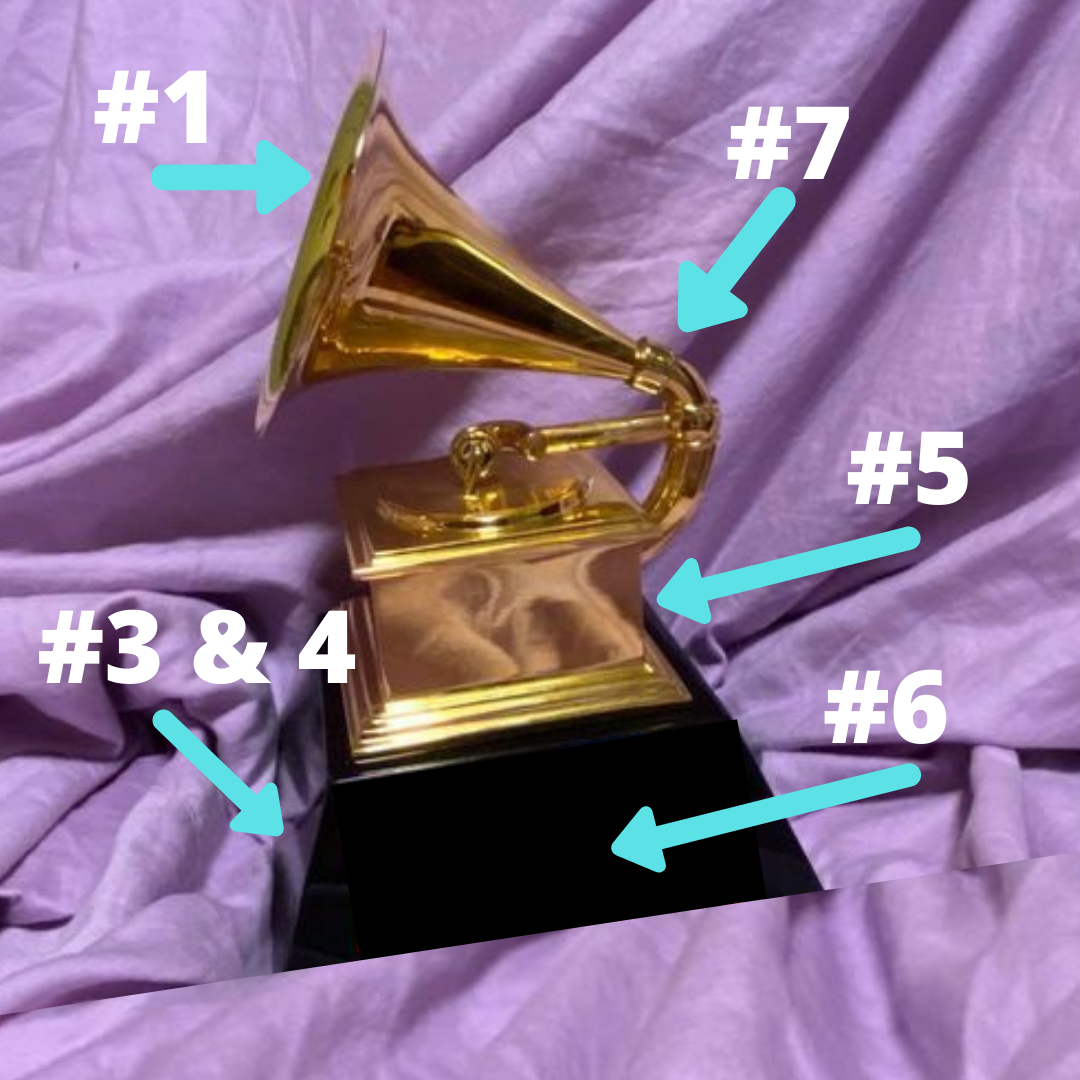Is your child drinking out of their Grammy award? Is it safe? What every parent of a Grammy-winning child needs to know.
Scroll down to read the full XRF test results for a Grammy award statuette!
For those new to this website:
Tamara Rubin is a multiple-federal-award-winning independent advocate for childhood Lead poisoning prevention and consumer goods safety, and a documentary filmmaker. She is also a mother of Lead-poisoned children (two of her sons were acutely Lead-poisoned in 2005). Since 2009, Tamara has been using XRF technology (a scientific method used by the U.S. Consumer Product Safety Commission) to test consumer goods for toxicants (specifically heavy metals — including Lead, Cadmium, Mercury, Antimony, and Arsenic). Tamara’s work was featured in Consumer Reports Magazine in February 2023 (March 2023 print edition).
A letter to Beyoncé
Friday — March 19, 2021
Dear Beyoncé,
I am a Lead poisoning prevention activist and a mother of Lead-poisoned children. Your husband and I actually have a mutual friend (who shall remain unnamed — but is also a parent of a child who tested positive for Lead in their blood). I spend a lot of time each day educating parents about where Lead can be found in everyday objects (so they can stay informed and protect their kiddos!). I also do independent consumer goods testing for toxicants using XRF technology. I primarily look for Lead, Cadmium, Arsenic, Mercury, and Antimony (as metals to be avoided in consumer goods used by children). Here’s an article discussing the Lead testing methods I use.
As soon as I saw the picture of your daughter drinking from her Grammy (congratulations to both of you, by the way!), I became a bit alarmed that it might be possible for the Grammy statue to be made of metals that could include unsafe levels of Lead or other harmful chemicals (specifically toxic heavy metals), which could be a problem if the award is used as a beverage container! (And, would be especially concerning if it were used for acidic beverages like soda, lemonade, tea, or coffee.) Several friends and readers familiar with my work had the same concerns upon seeing that image, too!
Luckily, I have many amazing musical friends and one of my friends “in the neighborhood” won a Grammy in 2019. I asked him if I could borrow it for a little bit, test it, and share the test results with the readers of my website and with my followers on Instagram. He said, “Yes, of course!”
Also, luckily (for you and for any other parent whose Grammy-winning child might consider using the statuette as a vessel for drinking beverages), I am happy to share with you that using both reactive agent testing shown in the videos on my Instagram feed today AND using XRF technology proved the Grammy statuette to be negative for toxicants. Specifically, it was negative for the following metals (using XRF technology): Lead, Cadmium, Mercury, Arsenic, and Antimony. (Scroll down to the bottom of this article to see the full XRF test results for my friend’s Grammy award — including how much Gold it has!) Please let your daughter know that I expect it is relatively safe for her to continue drinking from her Grammy (at least from a metals perspective)!
An important detail though (discussed below): As it turns out, up until 1990 these awards were actually made of Lead! So if you have an older Grammy (for example, one from when YOU yourself were 9 years old), I would make sure it is in a case behind glass and not used by children for any purposes at all.
Sincerely,
“Auntie Tammy”
(… that’s what the kids of my friends and readers call me!)
P.S. If you ever would like me to come test the things in your home for Lead, please do be in touch. I make house calls! I also do Zoom consults. There are also over 2,700 articles and pages with freely available information here on the site (for parents to explore). Parents can easily look up the consumer goods in their homes and find out if they are positive for heavy metal toxicants — so they can have a sense if things are safe for their children — or not! A good place to start is the link in my Instagram profile.
Stay safe out there!
#LeadSafeMama
Tamara Rubin
FULL XRF TEST RESULTS for the GRAMMY AWARD pictured here,
continue reading below the image
Component #1.) Bell of the gramophone — 30-second reading
Mostly COPPER and NICKEL
- Gold (Au): 116,000 +/- 2,300 ppm (12% Gold!)
- Zinc (Zn): 34,300 +/- 1,400 ppm
- Copper (Cu): 313,600 +/- 2,400 ppm
- Nickel (Ni): 534,800 +/- 2,800 ppm
Component #2.) Logo area on bottom of award — 30-second reading
Mostly ZINC
- Barium (Ba): 5,967 +/- 434 ppm
- Gold (Au): 32,600 +/- 7,500 ppm (3.3%)
- Platinum (Pt): 11,500 +/- 1,800 ppm
- Zinc (Zn): 858,300 +/- 10,000 ppm
- Iron (Fe): 581 +/- 287 ppm
- Vanadium (V): 21,500 +/- 2,300 ppm
- Titanium (Ti): 66,700 +/- 4,100 ppm
Component #3.) The plain black part of the base — 30-second reading
Mostly ZINC
- Barium (Ba): 12,400 +/- 1,900 ppm
- Chromium (Cr): 2,069 +/- 988 ppm
- Gold (Au): 42,800 +/- 7,200 ppm (4.3%)
- Platinum (Pt): 9,996 +/- 1,645 ppm
- Zinc (Zn): 544,700 +/- 57,000 ppm
- Iron (Fe): 616 +/- 283 ppm
- Manganese (Mn): 1,360 +/- 499 ppm
- Vanadium (V): 34,800 +/- 2,800 ppm
- Titanium (Ti): 75,800 +/- 4,600 ppm
Component #4.) The plain black part of the base (second reading) — 30-second reading
Mostly ZINC
- Barium (Ba): 13,500 +/- 1,800 ppm
- Chromium (Cr): 1,974 +/- 941 ppm
- Gold (Au): 38,000 +/- 5,600 ppm (4%)
- Platinum (Pt): 9,758 +/- 1,392 ppm
- Zinc (Zn): 439,100 +/- 40,000 ppm
- Iron (Fe): 666 +/- 272 ppm
- Manganese (Mn): 1,438 +/- 488 ppm
- Vanadium (V): 28,000 +/- 2,600 ppm
- Titanium (Ti): 72,200 +/- 4,500 ppm
Component #5.) Golden box of the gramophone — 30-second reading
Mostly NICKEL
- Gold (Au): 144,700 +/- 2,400 ppm (14%)
- Platinum (Pt): 3,449 +/- 975 ppm
- Zinc (Zn): 42,800 +/- 1,500 ppm
- Copper (Cu): 96,400 +/- 1,500 ppm
- Nickel (Ni): 709,900 +/- 2,900 ppm
- Cobalt (Co): 1,017 +/- 338 ppm
Component #6.) Nameplate of the award — 30-second reading (no gold!)
Mostly IRON
- Zinc (Zn): 66,500 +/- 1,400 ppm
- Copper (Cu): 199,600 +/- 2,300 ppm
- Iron (Fe): 728,800 +/- 2,400 ppm
- Manganese (Mn): 2,795 +/- 504 ppm
Component #7.) “Nut” at end of gramophone bell — 60-second reading
Mostly NICKEL
- Lead (Pb): non-detect
- Cadmium (Cd): non-detect
- Mercury (Hg): non-detect
- Barium (Ba): non-detect
- Chromium (Cr): non-detect
- Antimony (Sb): non-detect
- Selenium (Se): non-detect
- Gold (Au): 104,000 +/- 1,600 ppm (10%)
- Zinc (Zn): 3,601 +/- 470 ppm
- Copper (Cu): 12,700 +/- 800 ppm
- Nickel (Ni): 787,400 +/- 2,000 ppm
Surprises and unexpected findings with this XRF testing
- Needless to say, I was quite surprised that even join points/solder points did not test positive for trace amounts of Lead. This is truly exciting to learn.
- Given the weight of the piece (you could really clonk someone over the head with one of these in a pinch, if necessary!), I initially thought the base was made of stone but after repeated tests showed that it ALSO tested positive for GOLD, I realized it must be metal. It was then I deduced that the whole object is likely heavily gold-plated and then the black final finish plating of the bottom (an enamel of sorts) is plated OVER the gold-plating.
- Along the same lines, it was also interesting that the BOTTOM (which you cannot even see) tested positive for quite a bit of GOLD.
- Given I find a lot of modern Gold items today to be contaminated with both Mercury and Arsenic, it was great to see this tested negative for both of those toxic metals.
- I thought it was lovely that even the NAMEPLATE of the award (not shown in these pictures — to protect my friend’s identity, lol) was negative for Lead.
- Given online articles about the value and makeup of these awards note that it is made of a proprietary base of Zinc and other metals (“grammium” — see image below), I was surprised to see that some components of the piece are about 80% Nickel!
- The Grammy Awards actually were made of LEAD prior to 1990 (also noted in the image below), so my concerns were not too far out of left field on this one!
As always, thank you for being here, and thank you for reading and sharing these articles!
Tamara Rubin
#LeadSafeMama
Owner — Lead Safe Mama, LLC
Never Miss an Important Article Again!
Join our Email List











